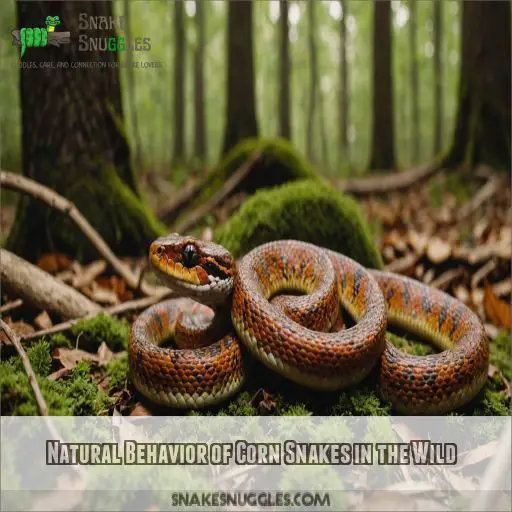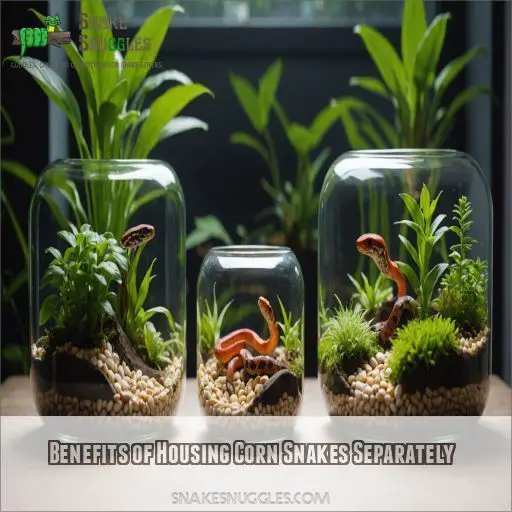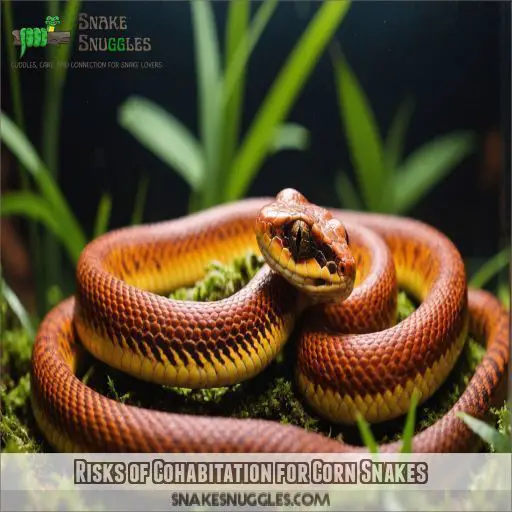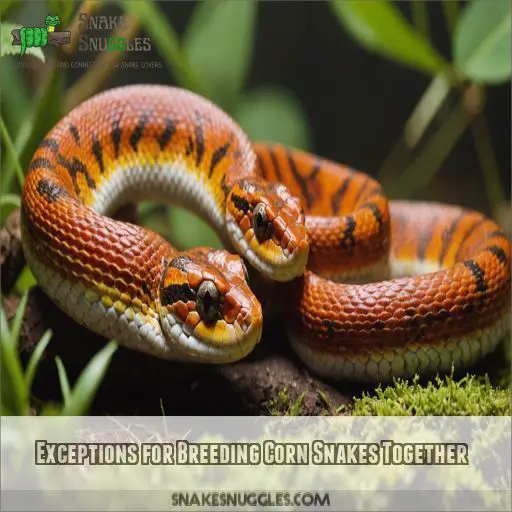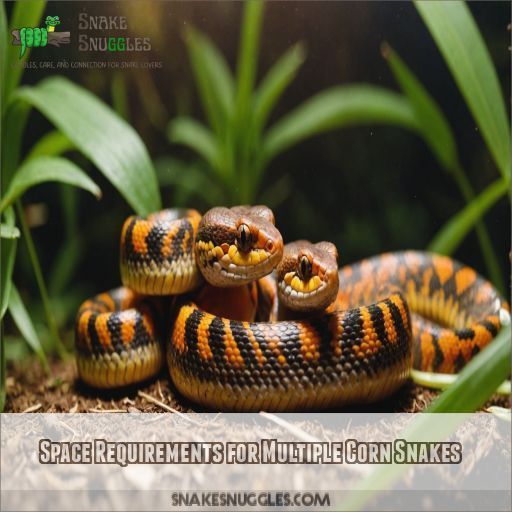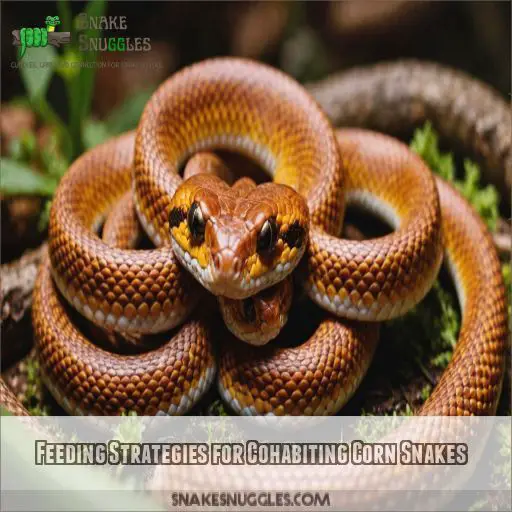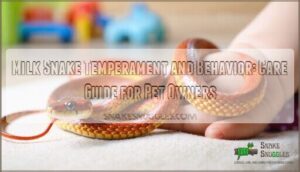This site is supported by our readers. We may earn a commission, at no cost to you, if you purchase through links.
 You’re wondering if two corn snakes can be housed together. Honestly, it’s not the best idea.
You’re wondering if two corn snakes can be housed together. Honestly, it’s not the best idea.
Corn snakes are naturally solitary creatures, and cohabitation can lead to stress, aggression, and even cannibalism. They’re territorial and prefer to hunt alone, so putting them together can spark competition for resources.
Housing them separately reduces stress, makes health monitoring easier, and prevents potential aggression issues. Think of it like living with a roommate – sometimes it works, but often it’s a recipe for disaster.
Can two corn snakes be housed together? Not recommended, but there’s more to explore…
Table Of Contents
- Key Takeaways
- Natural Behavior of Corn Snakes in the Wild
- Benefits of Housing Corn Snakes Separately
- Risks of Cohabitation for Corn Snakes
- Exceptions for Breeding Corn Snakes Together
- Space Requirements for Multiple Corn Snakes
- Creating Separate Territories Within One Enclosure
- Feeding Strategies for Cohabiting Corn Snakes
- Signs of Stress in Cohabiting Corn Snakes
- Alternative Housing Solutions for Multiple Corn Snakes
- Frequently Asked Questions (FAQs)
- Can two corn snakes live in the same tank?
- Do corn snakes do well in pairs?
- How many corn snakes can be kept together?
- Can adult corn snakes live together?
- What size terrarium is ideal for cohabiting corn snakes?
- How do I introduce two corn snakes to the same enclosure?
- Can I house corn snakes with other snake species together?
- How often should I clean the enclosure with multiple corn snakes?
- What are the best hiding places for cohabiting corn snakes?
- Conclusion
Key Takeaways
- When considering housing two corn snakes together, remember that they are naturally solitary creatures, and cohabitation can lead to stress, aggression, and even cannibalism – it’s like trying to force two introverts to be roommates, not a great idea!
- You’ll want to prioritize separate housing for your corn snakes, as it reduces stress, makes health monitoring easier, and prevents potential aggression issues – think of it like giving each snake its own cozy little apartment, complete with all the amenities!
- If you do decide to breed your corn snakes, temporary cohabitation during mating season can be okay, but make sure you’re carefully planning and monitoring their interactions to avoid any snake drama – it’s like setting up a blind date, but with more hissing and less wine!
- To keep your corn snakes happy and healthy, focus on providing a spacious, well-designed enclosure with plenty of hiding spots, visual barriers, and a temperature gradient – it’s like creating a snake paradise, minus the snake spa days (although, who knows, maybe that’s a thing too)!
Natural Behavior of Corn Snakes in the Wild
You might think corn snakes are social creatures, but their wild behavior tells a different story. In nature, these slithery friends lead solitary lives, only coming together for brief encounters during mating season or when competing for the same tasty mouse.
Solitary Nature of Corn Snakes
You might be surprised to learn that corn snakes are solitary creatures by nature. In the wild, they prefer to live alone, coming together only for specific purposes. Here’s what you need to know about their solo lifestyle:
- Naturally independent
- Territorial behavior
- Limited social interaction
- Prefer isolated hunting
- Stress-free when alone
Mating Habits and Seasonal Interactions
In the wild, corn snakes’ love lives are far from boring. You’ll find these slithery sweethearts engaging in elaborate courtship rituals during breeding season. Males compete for females’ attention, showing off their best moves. After mating, females seek out cozy spots to lay their eggs.
Territorial Behavior and Competition for Resources
In the wild, corn snakes establish dominance hierarchies to cope with resource scarcity. You’ll find these solitary creatures fiercely competing for food and space. They’ll often engage in territorial disputes, dividing their habitat to avoid confrontations. This behavior’s key to understand for proper pet snake care.
Benefits of Housing Corn Snakes Separately
While corn snakes can technically cohabitate, housing them separately offers some surprising benefits you mightn’t have considered. From reducing stress to making health monitoring a breeze, let’s explore why giving your scaly friends their own bachelor pads might be the way to go.
Reduced Stress For Snakes
Imagine your corn snake basking in stress-free solitude. By housing them separately, you’re giving your scaly friend a VIP retreat. With ample space, personalized hiding spots, and no competition for resources, your snake can truly unwind. It’s like a reptilian spa day, every day!
Easier Monitoring Of Health
You’ll find it’s a breeze to keep tabs on your scaly friend’s well-being when they’re flying solo. Individual health checks become a walk in the park, letting you spot any potential issues before they snowball. It’s like having a front-row seat to your snake’s health journey!
Prevents Potential Aggression Issues
By housing your corn snakes separately, you’re nipping potential aggression in the bud. Even these typically docile reptiles can develop a dominance hierarchy, leading to stress and conflict. Your pro reptile move? Giving each snake its own space, complete with aspen shavings and personalized habitat design.
Risks of Cohabitation for Corn Snakes
You might think housing two corn snakes together is a great idea, but it’s not all sunshine and rainbows in snake paradise. Let’s uncover the hidden dangers of corn snake cohabitation that could turn your reptile roommates into stressed-out, scaly frenemies.
Stress and Aggression Between Snakes
You might think corn snakes are laid-back, but cohabitation can lead to a reptilian ruckus. Watch for signs of dominance hierarchy and stressed-out body language in your scaly pals.
Competition for Food and Resources
When corn snakes cohabitate, it’s not all peace and harmony. They’ll duke it out for the best basking spots, hides, and even that juicy mouse dinner!
Potential for Cannibalism
While food competition’s concerning, there’s a darker side to cohabitation. You might be shocked to learn that corn snakes can turn on each other, becoming unwitting cannibals!
Increased Risk of Disease Transmission
- Shared water sources become microbial hotspots
- Stress weakens immune systems, making snakes more susceptible
- Close contact facilitates parasite transmission
- One sick snake can quickly infect the entire enclosure
Difficulty Monitoring Individual Health and Feeding
You’ve tackled disease risks, but there’s another challenge: keeping tabs on each snake’s health and eating habits. It’s like playing detective with scaly roommates!
| Monitoring Aspect | Single Snake | Multiple Snakes |
|---|---|---|
| Weight Tracking | Easy peasy | Who ate what? |
| Appetite Changes | Crystal clear | Mixed signals |
| Parasite Detection | Spot-on | Hide-and-seek |
| Feeding Frequency | Like clockwork | Juggling act |
Exceptions for Breeding Corn Snakes Together
While corn snakes are generally solitary creatures, there’s one exception to the "no roommates" rule: breeding time. If you’re looking to play matchmaker for your scaly friends, temporary cohabitation during mating season can be appropriate but it requires careful planning and monitoring to make sure everyone stays happy and healthy.
Temporary Cohabitation During Mating Season
While cohabitation’s risky, there’s an exception: mating season. You’ll need to temporarily house your corn snakes together for breeding. Here’s what to expect:
- Increased activity and exploration
- Male courting behaviors
- Possible female resistance
- Heightened feeding responses
Proper Timing and Duration for Breeding Pairs
If you’re thinking about breeding your corn snakes, timing is everything. You’ll want to introduce your corn snake lovebirds during breeding season, typically from March to May. Keep them together for about two weeks, giving Cupid plenty of time to work his magic.
Monitoring and Separating After Successful Mating
After successful mating, keep a watchful eye on your female corn snake. She’ll need her own space to prepare for motherhood. Look for telltale signs of pregnancy and separate her promptly. This helps create a stress-free environment for egg-laying and protects potential hatchlings.
Space Requirements for Multiple Corn Snakes
If you’re thinking about housing multiple corn snakes together, you’ll need to think carefully about their space requirements. Let’s explore how much room these slithery roommates really need to thrive and avoid turning your terrarium into a snake soap opera.
Minimum Enclosure Size for Single Snakes
While breeding’s a topic for another day, let’s slither into the space your scaly friend needs. For a single corn snake, you’ll want to start with a 10-gallon tank for babies. As they grow, upgrade to at least a 20-gallon home for adults.
Additional Space Needed for Multiple Snakes
When housing multiple corn snakes, you’ll need to think bigger than a single snake’s digs. Double the space, at least! For two snakes, aim for a 40-gallon tank minimum. Remember, these slithery pals love to explore, so more room means happier snakes.
Importance of Vertical and Horizontal Space
While floor space matters, don’t forget your corn snakes love to climb! Vertical space is just as important. When housing multiple snakes, remember:
- Each needs its own territory
- Climbing branches provide enrichment
-
More snakes = bigger tank
Give your slithery pals room to stretch!
Creating Separate Territories Within One Enclosure
As you consider housing multiple corn snakes together, you’ll want to create separate territories within the enclosure to reduce stress and competition between them. By incorporating multiple hiding spots, basking areas, visual barriers, and dividers, you can help each snake feel like it has its own little slice of heaven, minimizing the risk of aggression and stress-related issues.
Multiple Hiding Spots and Basking Areas
Now that you’ve considered the space requirements, let’s create a harmonious habitat. Add multiple hiding spots and basking areas to reduce stress and competition. This will give each snake its own territory, promoting a sense of security and well-being.
Visual Barriers and Dividers
- Tank Divider Options: Use a PVC pipe or acrylic divider to separate the space.
- Visual Barrier Ideas: Add plants, branches, or rocks to create a natural barrier.
- DIY Enclosure Separators: Repurpose a plastic container or cardboard box to create a unique separator.
Maintaining Proper Temperature Gradients for Each Snake
To maintain proper temperature gradients for each snake, you’ll need to get creative. Here’s a rough guide to get you started:
| Heat Source | Temperature Gauge Placement | Thermal Gradient |
|---|---|---|
| Heat Lamp | Near basking spot | 85-90F (30-32C) |
| Heat Mat | Under substrate | 75-80F (24-27C) |
| Heat Rock | In basking spot | 90-95F (32-35C) |
| None | Cooler area | 70-75F (21-24C) |
Remember to monitor temperatures closely to maintain a safe and healthy environment.
Feeding Strategies for Cohabiting Corn Snakes
When housing two corn snakes together, you’ll need to get creative with feeding time to prevent food-related aggression and guarantee each snake is getting its fair share. By setting up separate feeding areas or containers, you can monitor individual food intake and keep the peace in your multi-snake household.
Separate Feeding Areas or Containers
When feeding cohabiting corn snakes, you’ll want separate areas or containers to prevent food-related aggression. Consider feeding box options, hiding spot feeders, or tube feeding stations to create segregated meal areas and reduce stress during mealtime.
Monitoring Individual Food Intake
Now that you’ve set up separate feeding areas, it’s time to monitor individual food intake. Keep a food record for each snake, tracking weight, prey size, feeding frequency, and appetite changes. This helps you identify potential issues early on.
- Use a feeding log to track each snake’s meals
- Weigh your snakes regularly to monitor weight changes
- Adjust prey size based on individual snake’s needs
- Observe appetite changes to detect potential health issues
- Be prepared to adjust feeding frequency as needed
Preventing Food-related Aggression
To prevent food-related aggression, separate your corn snakes during meals, and consider feeding them in individual containers. Also, make sure the prey size is suitable for each snake, and avoid overfeeding, as this can lead to stress and aggression.
Signs of Stress in Cohabiting Corn Snakes
When housing two corn snakes together, it’s really important to monitor their behavior closely, as even subtle changes can indicate stress. Look out for red flags like changes in activity levels, loss of appetite, visible injuries, or excessive hiding – these signs can be your snake’s way of telling you that cohabitation just isn’t working out.
Changes in Behavior or Activity Levels
When housing corn snakes together, stress can manifest in behavior changes. Look out for these red flags:
- Altered movement speed
- Unusual nocturnal shifts
- Increased hiding
- Changes in exploration
- Restlessness
Loss of Appetite or Weight
You notice your cohabiting corn snakes eating less or losing weight, check for stress, husbandry issues, parasites, medical conditions, or nutritional deficiency, and adjust their care accordingly.
| Possible Causes | Actions to Take |
|---|---|
| Stress | Separate snakes, provide proper hiding spots and temperature gradients |
| Parasites | Consult a veterinarian, perform fecal exams, and administer treatment |
| Nutritional Deficiency | Review feeding schedule, provide varied prey items, and consider supplements |
Visible Injuries or Scale Damage
Noticing scale rubs or wounds on your cohabiting corn snakes? Inspect for signs of infection, parasites, or stress, and prioritize prevention to help their wound healing and overall well-being.
Hiding Excessively or Unusual Positioning
You notice your cohabiting corn snakes hiding excessively or positioning themselves unusually – what’s going on? Check for stress indicators:
- Are there enough hiding spots?
- Is the enclosure too small?
- Are environmental factors off?
- Have you observed other behavioral changes?
- Are there underlying health concerns?
Alternative Housing Solutions for Multiple Corn Snakes
You’re considering housing multiple corn snakes together, but you want to avoid the potential risks and stress that come with cohabitation. Fortunately, there are alternative housing solutions that can provide your snakes with a safe and healthy environment, such as separate but adjacent enclosures, rotating snakes between enclosures, and creating a multi-level habitat system.
Separate but Adjacent Enclosures
Consider housing your corn snakes in separate but adjacent enclosures. This setup allows for easy monitoring, individualized care, and stress reduction while still providing a sense of companionship – just make sure to follow proper space and ventilation guidelines!
Rotating Snakes Between Enclosures
Rotating your corn snakes between enclosures can be a great way to provide mental and environmental stimulation. Just be sure to switch them at a frequency that doesn’t stress them out, such as every two to four weeks.
Creating a Multi-level Habitat System
Creating a multi-level habitat system can be a DIY dream come true! Utilize vertical space with stacked enclosures or shelves, ensuring each snake has its own territory. Just remember to prioritize safety and easy cleaning.
Frequently Asked Questions (FAQs)
Can two corn snakes live in the same tank?
You can house two corn snakes together, but monitor them closely for signs of breeding or stress. Make sure you have a spacious tank (at least 20 gallons) with plenty of hides and visual barriers to reduce competition.
Do corn snakes do well in pairs?
You’re wondering if corn snakes do well in pairs? Generally, they can be housed together, but keep an eye out for breeding, and make sure the tank is escape-proof with plenty of space and hiding spots.
How many corn snakes can be kept together?
Housing a million corn snakes together might sound like a snake lover’s dream, but realistically, it’s best to keep adults in pairs, and only if you can monitor for breeding and provide a spacious, escape-proof enclosure.
Can adult corn snakes live together?
You’re wondering if adult corn snakes can live together? Generally, it’s not recommended as they’re solitary animals and may fight, but some breeders successfully keep females together, monitoring for stress and providing a spacious enclosure (Source).
What size terrarium is ideal for cohabiting corn snakes?
Like planning a dinner party, cohabiting corn snakes require ample space. A minimum 40-gallon terrarium is ideal, providing enough room for two adult snakes to live comfortably, climb, and bask without feeling like they’re stuck in a snake jam.
How do I introduce two corn snakes to the same enclosure?
Can I house corn snakes with other snake species together?
Housing corn snakes with other species is like trying to blend oil and water – it’s a recipe for disaster! Mixing species can lead to stress, competition, and even predation, so it’s best to keep them solo.
How often should I clean the enclosure with multiple corn snakes?
When housing multiple corn snakes, clean the enclosure at least weekly, removing feces and uneaten prey immediately. Disinfect all surfaces and accessories every 2-3 weeks to prevent bacterial and fungal growth.
What are the best hiding places for cohabiting corn snakes?
The hide-and-seek conundrum! You’ll want to provide at least two hiding places per snake, mixing up the sizes and textures. Think rocks, plants, and logs – the ultimate snake hideaways – to keep your cohabiting corn snakes stress-free!
Conclusion
Housing two corn snakes together is a recipe for disaster. Their naturally solitary nature can lead to stress, aggression, and even cannibalism.
So, can two corn snakes be housed together? Unfortunately, it’s not recommended.

